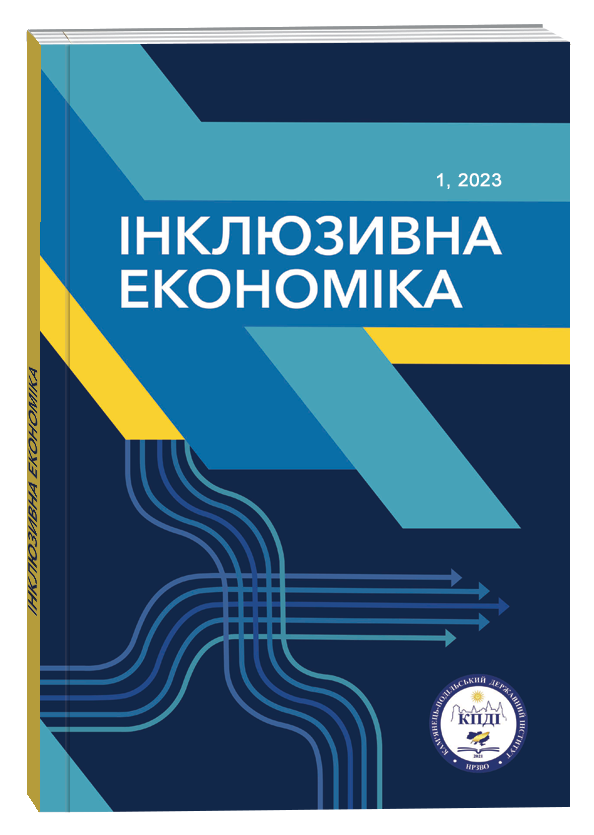MARKETING TECHNOLOGIES FOR PROMOTING A HIGHER EDUCATION INSTITUTION BRAND ON THE EDUCATION MARKET
DOI:
https://doi.org/10.32782/inclusive_economics.1-1Keywords:
brand, marketing technologies, communication channels, event activities, social media, viral marketingAbstract
The article describes the information approaches to ensuring the process of managing the competitiveness of higher educational institutions (HEIs) and defines the role of social networks and branding tools in the process of managing the competitiveness of HEIs. The concept of the "7P" of an educational institution's brand components is justified. Should become components of the HEIs brand: product, price, place, promotion, people, process, perceptibility. It is suggested that HEIs form a system of marketing communications by combining both traditional and innovative channels, including three interconnected directions of activity on the Internet: event marketing tools, social networks, and viral marketing. Events, both formal and informal education, include an assembly, an open space, an exhibition, a workshop, a debate, a meeting, a meeting, a convention, a take-off, a party, a congress, a competition, a conference, a round table, a meeting, a panel discussion, press conference, summit, session, symposium, seminar, festival, forum, fair, etc. The author states that the main goal of event activities is to leave a positive impression on the invitees about the educational institution as a whole and to foster a preference for choosing the educational offerings of this particular institution. It is noted that advertising an educational institution on social media platforms is characterized by wide territorial coverage, persuasive capabilities, the ability to present the product in an expressive and impactful manner, and a social nature. The use of viral marketing techniques is proposed as the most successful method for promoting and popularizing educational institution products among young people. The significant disadvantages of Internet communications include the constant need to monitor the social network and the technical instability of communications, which leads to the fact that some messages do not arrive, and the user often finds himself in the feeling of «broken communication» when his message went, but the answers to it nobody heard.
References
Бенедик Ю. Ю. Вплив бренду державного вищого навчального закладу України на його фінансову стійкість. Наукові записки. Серія «Економіка». 2010. Вип. 14. С. 94–101.
Волошенюк А. Конкурентоспроможність бренду у виборі абітурієнтами закладу вищої освіти: управлінські виклики. Актуальні проблеми державного управління. 2021. № 1(82). С. 73–78.
Іванова Л. О., Вовчанська О. М. Соціальні мережі як чинник посилення впливу маркетингу на лояльність клієнтів ресторанних закладів. URL: http://www.intellect21.nuft.org.ua/journal/2019/2019_2/8.pdf
Ogilvy On Advertising. URL: https://www.scribd.com/doc/181127154/Ogilvy-on-Advertising
Почепцов Г. Паблик рилейшнз для профессионалов. М. : Рефлбук; К. : Ваклер, 2003. 624 с.
Рассказова О. Л. Освітні івенти як засіб формування громадянськості в неформальній освіті дорослих. Вісник Глухівського національного педагогічного університету ім. О. Довженка. Педагогічні науки. 2017. Вип. 35. С. 269–280.
Семенюк С. Брендинг вищого навчального закладу. Галицький економічний вісник. 2013. № 3(42). С. 133–138.
Сорока О. В., Кривцов М. С. Бренд закладу вищої освіти – основа конкурентоспроможності на ринку освітніх послуг. URL: http://www.visnyk-econom.uzhnu.uz.ua/archive/19_3_2018ua/15.pdf
Most popular social networks worldwide as of January 2023, ranked by number of monthly active users. URL: https://www.visualcapitalist.com/ranked-social-networks-worldwide-by-users/
Benedik Yu. Yu. (2010) The influence of the brand of the state higher educational institution of Ukraine on its financial stability. Proceedings. «Economy» series. No. 14. P. 94–101.
Volosheniuk A. (2021) Competitiveness of the brand in the choice of higher education institutions by applicants: management challenges. Actual problems of public administration. No. 1(82). P. 73–78.
Ivanova L. O., Vovchanska O. M. Social networks as a factor of increasing the influence of marketing on the loyalty of restaurant customers. Available at: http://www.intellect21.nuft.org.ua/journal/2019/2019_2/8.pdf
Ogilvy On Advertising. Available at: https://www.scribd.com/doc/181127154/Ogilvy-on-Advertising
Pocheptsov G. (2003) Public relations for professionals. M. : Reflbook; K. : Vakler. 624 p.
Rasskazova O. L. (2017) Educational events as a means of forming citizenship in non-formal adult education. Bulletin of the Glukhiv National Pedagogical University named after O. Dovzhenka. Pedagogical sciences. No. 35. P. 269–280.
Semenyuk S. (2013) Branding of a higher educational institution. Galician Economic Bulletin. No. 3(42). P. 133–138.
Soroka O. V., Kryvtsov M. S. The brand of a higher education institution is the basis of competitiveness in the market of educational services. Available at: http://www.visnyk-econom.uzhnu.uz.ua/archive/19_3_2018ua/15.pdf
Most popular social networks worldwide as of January 2023, ranked by number of monthly active users. Available at: https://www.visualcapitalist.com/ranked-social-networks-worldwide-by-users



